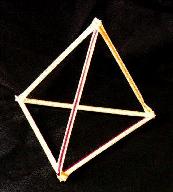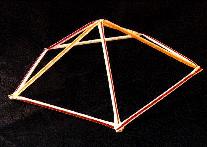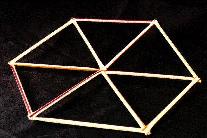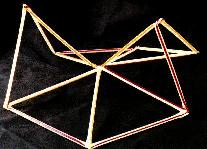 |
Intrinsic curvature experiment - Results
|
With three `spokes' we get a rigid shape. This is actually called
a tetrahedron (tetra because it has four vertices).
|

Bigger image
|

Bigger image
|
With five `spokes' we get another rigid shape, this time a five faced
pyramid with a pentagonal based.
|
|
With six `spokes' we see that all six equilateral triangles can lie in
one plane - the complete shape is flat.
|

Bigger image
|

Bigger image
|
With eight `spokes' the shape will not lie flat unless two triangles
are folded over reach other. By arranging the triangles it can
be made into a saddle shape where two directions go down (front and
back in the photo) and the perpendicular directions go up (left
and right in the photo).
|
What does all this mean?
If the triangles around a node (the central point here)
make a pyramid or cone shape physicists say that the curvature
near that node is positive. If they make a floppy saddle shape,
then we say that the curvature is negative. And if the triangles
around a node can lie flat on a table then we say that the triangulation
is flat near that node.
- How many equilateral triangles must surround a node for the
triangulation to be flat near that node?
- Look at the
triangulation
on the page about simulating quantum gravity.
Find places where the curvature is positive, negative
and flat. Remember to imagine that all of the links are the same length.
This curvature is a special kind of curvature called intrinsic
curvature.
This means that it is built into the surface and we don't need any
other information about where each of the nodes is located.
It is only on this page in this discussion on how to determine the
intrinsic curvature on a triangulation that we will think of the links
as all having the same length.
|


